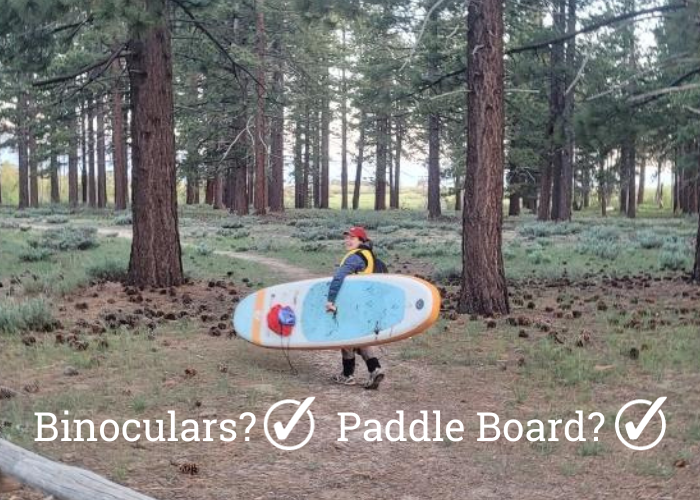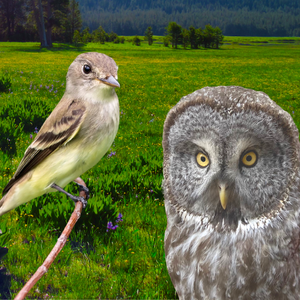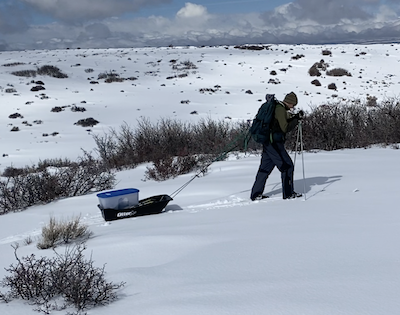
IBP Biologist Jerry Cole pulls autonomous recording unit equipment on a sled in Colorado.
You know it was an unusual field season when Willow Flycatcher surveys in the montane meadows of the Sierra Nevada required a stand-up paddle board! IBP’s 2023 field season was a doozy thanks in part to some “global weirding” (the changes in weather patterns due to global warming that lead to extreme precipitation events and heat waves and other anomalies) creating challenging field conditions. Thankfully IBP’s field crews are tenacious and creative, and were able to get the job done.
The year started off with snow and lots of it. IBP’s field sites in the Sierra and Colorado finally had good snow pack after years of drought. April Snowpack in the Sierra Nevada’s national parks ranged from 244% to 326% of average, while snowpack in Gunnison River Basin in Colorado came in at about 160% of average. There was also record snow farther south on the Southern Colorado Plateau where IBP is monitoring bird populations in National Parks like Grand Canyon and Canyon de Chelly. Flagstaff AZ, had its second highest snowpack on record.
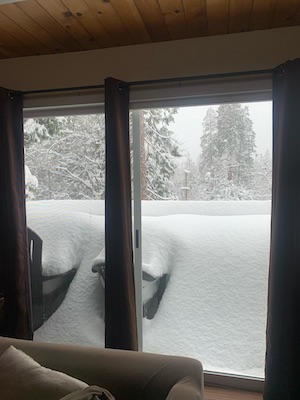
The view out the window at the field house for the Owl Crew in Twain Harte, CA.
This snow (and eventual river water) was badly needed but it definitely created some logistical hurdles. In early March, avalanches blocked the roads in and out of Lee Vining, CA where IBP Avian Acoustic Ecologist Mary Clapp lives, knocking out her water and power as well. Meanwhile in Colorado where IBP biologist Jerry Cole and our BLM partners were deploying autonomous recording units to listen for Gunnison Sage-grouse, snow drifts foiled even a tracked UTV (utility task vehicle), requiring the crew to deploy the units using cross-country skis and pulling their equipment in sleds.
Snow in the Sierra Nevada stuck around well into the start of field work for our owl crews. When Ramiro Aragon’s Spotted Owl crew arrived at the field house in Twain Harte, CA where they would be living for the season they practically had to dig a tunnel to the door. Field work for most of our projects in the Sierra was delayed for at least a couple of weeks because roads were blocked by snow or downed trees. IBP operates 6 MAPS bird banding stations in Yosemite National Park, one of which opened late and two of which did not operate this year at all due to lingering snow. Closure of Big Oak Flat Road after it was washed out by snowmelt made travel between some banding stations a multi-hour trip around the park rather than a quick couple-mile drive.
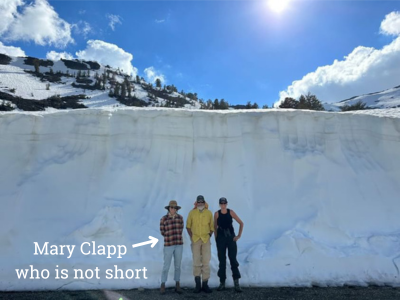
Mary Clapp and friends pose against the snow wall along the road to Tioga Pass near Yosemite in mid-June. Photo by Jess Malish.
Near Lee Vining, where Mary Clapp lives, the road through Tioga Pass into Yosemite National Park was not cleared of snow-related hazards and opened until July 22, the latest such opening since the route was established in 1915. Likewise, several of the high elevation sites in the Sierra region national parks where we typically survey birds were still inaccessible in late July, requiring a readjustment of the survey design.
All that snow eventually melts and runs downhill which lead to unusually wet conditions for the field crews. In the southwest, snowmelt flooded Canyon de Chelly and crew members had to do their surveys wading through knee to thigh deep water in some places. One upside: “wading through ice-cold meltwater does wake you up quickly!” said project leader and IBP’s Southwest Avian Ecologist Harry Jones.
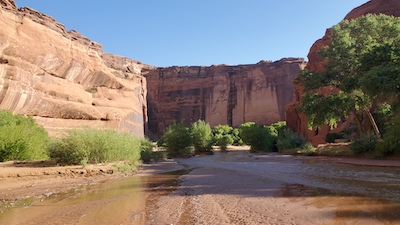
Unusually wet conditions in Canyon de Chelly. Photo by Harry Jones.
Snowmelt also posed challenges for our crews surveying birds in montane meadows in the Sierra Nevada. For many years the meadows have been abnormally dry due to drought and stream channelization, but this year formerly small creeks turned into raging streams that necessitated long detours to access field sites. Early in the season, many meadows morphed into temporary ponds too deep to wade through. So IBP biologist Emma Cox and her crew conducted bird surveys on stand-up paddle boards. (Surveying for birds while balancing on a drifting paddle board requires elite binocular skills.)
Emma Cox doing a point count via SUP near Truckee, CA.
Later in the season, when most of our fieldwork was done, the weirdness continued. California saw its first tropical storm in almost 30 years! And in the southwest, the monsoon rains on the Southern Colorado Plateau arrived late. That didn’t affect our bird survey crew there this year, but it may affect the monitoring results next year. (We’ll tell you more about that in an upcoming post about soon-to-be-released IBP research on how drought and the timing of the monsoon affect birds in this region.)
We’re thankful for our determined and resourceful field crew members- and the much needed precipitation. In the last decade or so, most of our field challenges have been due to wildfire and smoke. Not so this year! Let’s see what the 2024 field season brings- we may have to make some unusual additions to our equipment lists!


